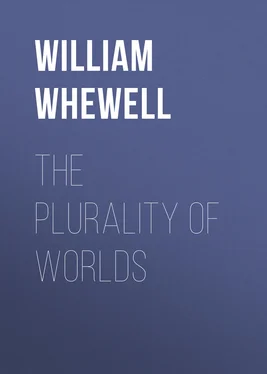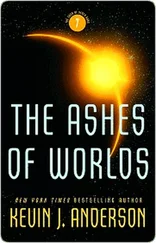William Whewell - The Plurality of Worlds
Здесь есть возможность читать онлайн «William Whewell - The Plurality of Worlds» — ознакомительный отрывок электронной книги совершенно бесплатно, а после прочтения отрывка купить полную версию. В некоторых случаях можно слушать аудио, скачать через торрент в формате fb2 и присутствует краткое содержание. Жанр: foreign_antique, Физика, foreign_edu, на английском языке. Описание произведения, (предисловие) а так же отзывы посетителей доступны на портале библиотеки ЛибКат.
- Название:The Plurality of Worlds
- Автор:
- Жанр:
- Год:неизвестен
- ISBN:нет данных
- Рейтинг книги:4 / 5. Голосов: 1
-
Избранное:Добавить в избранное
- Отзывы:
-
Ваша оценка:
- 80
- 1
- 2
- 3
- 4
- 5
The Plurality of Worlds: краткое содержание, описание и аннотация
Предлагаем к чтению аннотацию, описание, краткое содержание или предисловие (зависит от того, что написал сам автор книги «The Plurality of Worlds»). Если вы не нашли необходимую информацию о книге — напишите в комментариях, мы постараемся отыскать её.
The Plurality of Worlds — читать онлайн ознакомительный отрывок
Ниже представлен текст книги, разбитый по страницам. Система сохранения места последней прочитанной страницы, позволяет с удобством читать онлайн бесплатно книгу «The Plurality of Worlds», без необходимости каждый раз заново искать на чём Вы остановились. Поставьте закладку, и сможете в любой момент перейти на страницу, на которой закончили чтение.
Интервал:
Закладка:
4. But this is only the first step in the asserted revelations of astronomy. Some of the stars are, as we have said, planets of the kind just described. But these stars are a few only:—five, or at most six, of those visible to the unassisted eye of man. All the rest, innumerable as they appear, and numerous as they really are, are, it is found, objects of another kind. They are not, as the planets are, opaque globes, deriving their light from a sun, about which they circulate. They shine by a light of their own. They are of the nature of the sun, not of the planets. That they appear mere specks of light, arises from their being at a vast distance from us. At a vast distance they undoubtedly are; for even with our most powerful telescopes, they still appear mere specks of light;—mere luminous points. They do not, as the planets do, when seen through telescopes, exhibit to us a circular face or disk, capable of being magnified and distinguished into parts and features. But this impossibility of magnifying them by means of telescopes, does not at all make us doubt that they may be far larger than the planets. For we know, from other sources of information, that their distance is immensely greater than that of any of the planets. We can measure the bodies of the solar system;—the earth, by absolutely going round a part of it, or in other ways; the other bodies of the system, by comparing their positions, as seen from different parts of the earth. In this manner we find that the earth is a globe 8,000 miles in diameter. In this way, again, we find that the circle which the earth describes round the sun has, in round numbers, a radius about 24,000 times the earth's radius; that is, nearly a hundred millions of miles. The earth is, at one time, a hundred millions of miles on one side of the sun; and at another time, half a year afterwards, a hundred millions of miles on the other side. Of the bright stars which shine by their own light,—the fixed stars , as we call them, (to distinguish them from the planets, the wandering stars ,)—if any one were at any moderate distance from us, we should see it change its apparent place with regard to the others, in consequence of our thus changing our point of view two hundred millions of miles: just as a distant spire changes its apparent place with regard to the more distant mountain, when we move from one window of our house to the other. But no such change of place is discernible in any of the fixed stars: or at least, if we believe the most recent asserted discoveries of astronomers, the change is so small as to imply a distance in the star, of more than two hundred thousand times the radius of the earth's orbit, which is, itself, as we have said, one hundred millions of miles. 1 1 It is quite to our purpose to recollect the impression which such discoveries naturally make upon a pious mind. Oh! rack me not to such extent, These distances belong to Thee; The world's too little for Thy tent, A grave too big for me! George Herbert.
This distance is so vastly great, that we can very well believe that the fixed stars, though to our best telescopes they appear only as points of light, are really as large as our sun, and would give as much light as he does, if we could approach as near to them. For since they are thus, the nearest of them, two hundred thousand times as far off as he is, even if we could magnify them a thousand times, which we can hardly do, they would still be only one two-hundredth of the breadth of the sun; and thus, still a mere point.
5. But if each fixed star be of the nature of the sun, and not smaller than the sun, does not analogy lead us to suppose that they have, some of them at least, planets circulating about them, as our sun has? If the Sun is the centre of the Solar System, why should not Sirius, (one of the brightest of the fixed stars,) be the centre of the Sirian System ? And why should not that system have as many planets, with the same resemblances and differences of the figure, movements, and conditions of the different planets, as this? Why should not the Sirian System be as great and as varied as the solar system? And this being granted, why should not these planets be inhabited, as men have inferred the other planets of the solar system, as well as the earth, to be? And thus we have, added to the population of the universe of which we have already spoken, a number (so far as we have reason to believe) not inferior to the number of inhabitants of the solar system: this number being, according to all the analogies, very many fold that of the population of the whole earth?
And this is the conclusion, when we reason from one star only, from Sirius. But the argument is the same, from each of the stars. For we have no reason to think that Sirius, though one of the brightest, is more like our sun than any of the others is. The others appear less bright in various degrees, probably because they are further removed from us in various degrees. They may not be all of the same size and brightness; it is very unlikely that they are. But they may as easily be larger than the sun, as smaller. The natural assumption for us to make, having no ground for any other opinion, is, that they are, upon the average, of the size of our sun. On that assumption, we have as many solar systems as we have fixed stars; and, it may be, six or ten, or twenty times as many inhabited globes; inhabited by creatures of whom we must suppose, by analogy, that God is mindful, if he is mindful of us. The question recurs with overwhelming force, if we still follow the same train of reflection: "What is man, that God is mindful of him?"
6. But we have not yet exhausted the views which thus add to the force of this reflection. The fixed stars, which appear to the eye so numerous, so innumerable, in the clear sky on a moonless night, are not really so numerous as they seem. To the naked eye, there are not visible more than four or five thousand. The astronomers of Greece, and of other countries, even in ancient times, counted them, mapped them, and gave them names and designations. But Astronomy, who thus began her career by diminishing, in some degree, the supposed numbers of the host of heaven, has ended by immeasurably increasing them. The first application of the telescope to the skies discovered a vast number of fixed stars, previously unseen: and every improvement in that instrument has disclosed myriads of new stars, visibly smaller than those which had before been seen; and smaller and smaller, as the power of vision is more and more strengthened by new aids from art; as if the regions of space contained an inexhaustible supply of such objects; as if infinite space were strewn with stars in every part of it to which vision could reach. The small patch of the sky which forms, at any moment, the field of view of one of the great telescopes of Herschel, discloses to him as many stars, and those of as many different magnitudes, as the whole vault of the sky exhibits to the naked eye. But the magnifying power of such an instrument only discloses, it does not make, these stars. There appears to be quite as much reason to believe, that each of these telescopic stars is a sun, surrounded by its special family of planets, as to believe that Sirius or Arcturus is so. Here, then, we have again an extension, indefinite to our apprehension, of the universe, as occupied by material structures; and if so, why not by a living population, such as the material structures which are nearest to us support?
7. Even yet we have not finished the series of successive views which astronomers have had opened to them, extending more and more their spectacle of the fulness and largeness of the universe. Not only does the telescope disclose myriads of stars, unseen to the naked eye, and new myriads with each increase of the powers of the instrument; but it discloses also patches of light, which, at first at least, do not appear to consist of stars: Nebulæ , as they are called; bright specks, it might seem, of stellar matter, thin, diffused, and irregular; not gathered into regular and definite forms, such as we may suppose the stars to be. Every one who has noticed the starry skies, may understand what is the general aspect of such nebulæ, by looking at the milky way or galaxy, an irregular band of nebulous light, which runs quite round the sky; "A circling zone, powdered with stars;" as Milton calls it. But the nebulæ of which I more especially speak, are minute patches, discovered mainly by the telescope, and in a few instances only discernible by the naked eye. And what I have to remark especially concerning them at present is, that though to visual powers which barely suffice to discern them, they appear like mere bright clouds, patches of diffused starry matter; yet that, when examined by visual powers of a higher order, by more penetrating telescopes, these patches of continuous feeble light are, in many instances at least, distinguishable into definite points: they are found, in fact, to be aggregations of stars; which before appeared as diffused light, only because our telescopes, though strong enough to reveal to our senses the aggregate mass of light of the cluster, were not strong enough to enable us to discern any one of the stars of which the cluster consists. The galaxy, in this way, may, in almost every part, be resolved into separate stars; and thus, the multitude of the stars in the region of the sky occupied by that winding stream of light, is, when examined by a powerful telescope, inconceivably numerous.
Читать дальшеИнтервал:
Закладка:
Похожие книги на «The Plurality of Worlds»
Представляем Вашему вниманию похожие книги на «The Plurality of Worlds» списком для выбора. Мы отобрали схожую по названию и смыслу литературу в надежде предоставить читателям больше вариантов отыскать новые, интересные, ещё непрочитанные произведения.
Обсуждение, отзывы о книге «The Plurality of Worlds» и просто собственные мнения читателей. Оставьте ваши комментарии, напишите, что Вы думаете о произведении, его смысле или главных героях. Укажите что конкретно понравилось, а что нет, и почему Вы так считаете.











